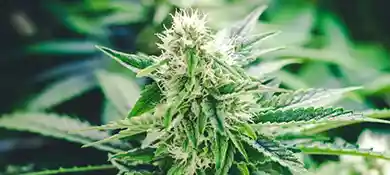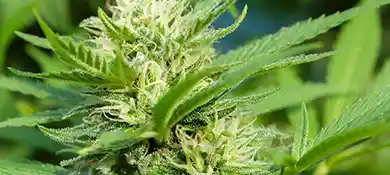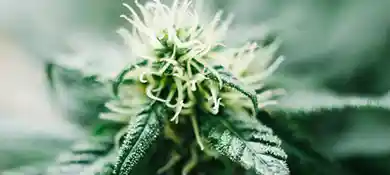Moldy Weed vs Trichomes: An In-Depth Guide to Cannabis Quality
Understanding the nuances between moldy weed and trichomes can be tricky yet crucial in the cannabis universe. Cannabis quality, as well as health, are significantly affected by it.
No one aims for a puff of moldy weed - it's dangerous and unpalatable. Trichomes, on the other hand, are the gems of cannabis plants. They're the little sparkly bits that crank out cannabinoids - the stuff that gets us to our happy place.
Yet, telling mold and trichomes apart isn't always easy. They might look similar but trust us, and they're worlds apart. This guide walks you through the labyrinth of their characteristics, including their appearance, taste, smell, and even how they look under a microscope. We'll also discuss preventing mold growth and promoting healthy trichomes.
Whether you're a first-time cannabis user or an old hand, you'll find something useful here. Ready? Let's get started!
Moldy Weed vs Trichomes: What You Must Know
Cannabis culture is a world of fine details and nuanced knowledge. A critical aspect of this knowledge involves distinguishing between trichomes and harmful intruders like mold. A thorough understanding of these elements can differentiate between a high-quality product and potential health risks.
Exploring Cannabis Mold
Before we delve into the specifics, it's essential to set the stage with an understanding of cannabis mold - a stealthy villain that can wreak havoc if not appropriately managed.
What is Mold in Cannabis?
Mold is a tricky fungus that loves damp, organic spaces. Cannabis, unfortunately, isn't off its radar. Most mold types won't harm you, but some produce harmful toxins. Any mold, toxic or not, ruins your cannabis plants, slashing the quality of the buds.
The harsh truth is, fighting mold is tough. Once it clings to your cannabis, it doesn't let go. And don't think your crop is mold-free just because you can't see any. Hidden villains like Botrytis lurk within your plant for weeks before they appear. By then, the damage is done, and your crop suffers.
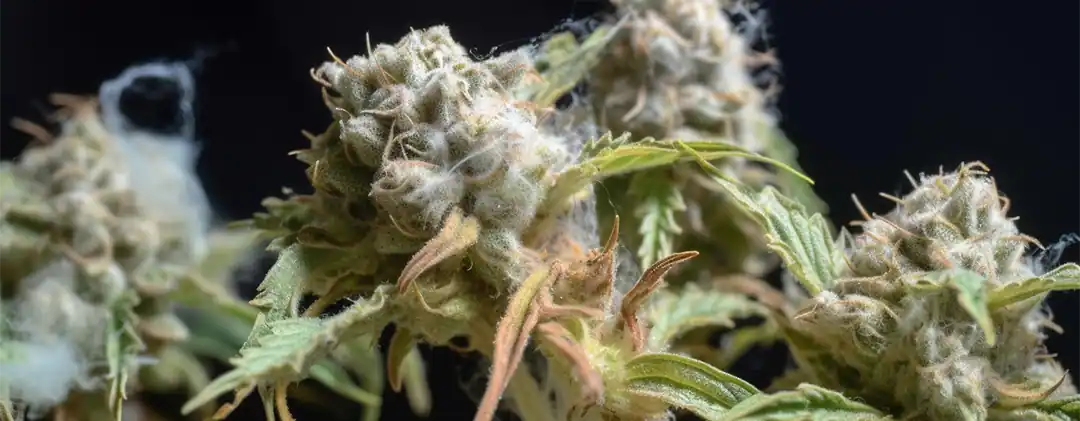
What Makes Weed Moldy?
Mold is a stubborn enemy that can invade cannabis plants under the right conditions. But let's delve deeper into these conditions, understanding that they're like puzzle pieces fitting perfectly together for mold to thrive.
- Oxygen: Like many living organisms, mold needs oxygen to survive and multiply. However, oxygen alone is not sufficient; the other pieces of the puzzle must also be in place.
- High Humidity: Humidity above 63% around your cannabis plants creates the perfect mold environment. This moisture, combined with oxygen, provides the damp conditions mold loves.
- Lack of Airflow: Poor ventilation sets the stage for mold. Tight spaces with limited air exchange are a mold's paradise. Regularly airing out your buds helps to maintain fresh air and disrupt the stale conditions where mold thrives.
- Temperature: Mold prefers the same temperatures that cannabis does, roughly between 70 and 80 degrees Fahrenheit. Therefore, the comfortable growing conditions for your cannabis are also inviting for mold growth.
- Poor Sanitation: If the growing area is not kept clean and free of dead plant material and waste, it can attract mold spores.
- Improper Drying and Curing: These post-harvest processes are crucial. If not done correctly, they can leave too much moisture in the buds, encouraging mold growth.
To keep it simple, don't mess with moldy weed. If you spot mold in your stash, toss it out.
What are the Risks of Moldy Weed?
You might shrug off the idea of using moldy weed, but it's a risky gamble that can backfire with substantial health implications. Although not all molds spell trouble, some are toxic producers that could harm your well-being.
- Allergy Triggers: If you're allergy-prone, mold exposure can set off unpleasant reactions, from skin flare-ups to a sudden coughing fit. Even if this is the first time you've reacted to mold, it's not worth rolling the dice, especially if you have allergies or respiratory conditions on your health radar.
- Respiratory Concerns: For folks with breathing issues or weakened immune systems, moldy cannabis can be a natural hazard. Dabbling with cannabis mold could lead to breathing troubles like coughing, wheezing, shortness of breath, and chest discomfort. If you have respiratory issues, moldy weed could pour oil on the fire.
- Other Health Hitches: Contact with moldy cannabis can stir up other health woes, including a blocked nose, itchy eyes, fever, tiredness, memory lapses, and on rare occasions, severe allergic responses. These symptoms can run the gamut from mildly annoying to downright incapacitating.
- Long-Term Impacts: While occasional mold contact might bring about temporary discomfort, chronic exposure can lay the groundwork for severe health conditions, including persistent lung diseases. So, it's best to play it safe and steer clear of moldy weed.
- Impact on Cannabis Quality: Mold doesn't just threaten your health; it also degrades the quality of your cannabis. By attacking the cannabinoids and terpenes, mold diminishes the potency and overall quality of the cannabis plant.
The Most Common Types of Cannabis Mold
In the vast kingdom of fungi, two unwelcome guests are most commonly seen in the world of cannabis: Powdery Mildew and Botrytis, more widely known as Grey Mold.
Powdery Mildew: The Deceptive Dust
Powdery mildew is a sneaky fungus that can be easily spotted with the naked eye. Appearing as a fine grey or white dusting that closely resembles powdered sugar or flour, it can easily be mistaken for a harmless residue.
Cannabis powdery mildew thrives in conditions of high humidity and insufficient air circulation. While it can survive in low humidity, it prefers environments where moisture levels are stable rather than fluctuating.It's most commonly found on plant leaves but can grow on buds and stems. Rarely, powdery mildew may show other signs like dark patches, dense spider webbing, or a slimy residue.
Unlike other fungi, this one doesn't pick a stage of development when it attacks your plants - even when they are still clones. If you're interested in a deep dive into this nuisance, check out our dedicated post on Powdery Mildew, where we explore its characteristics and effects on cannabis in more detail.
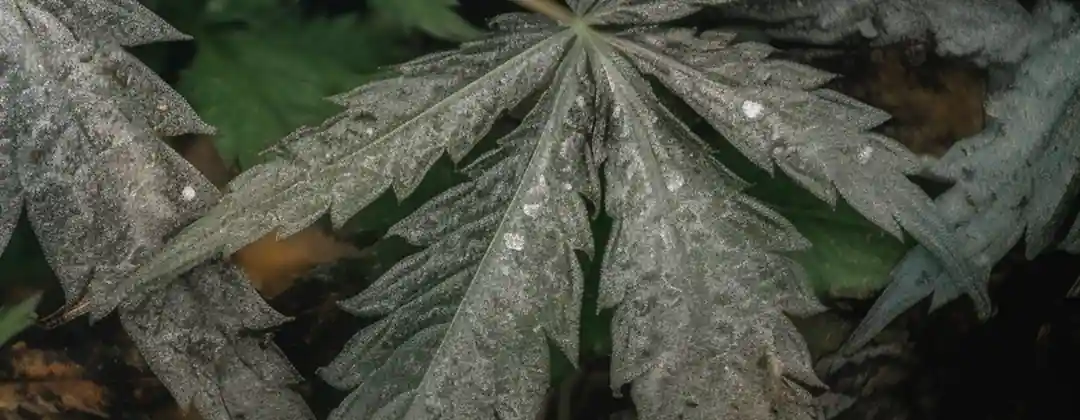
Botrytis: The Stealthy Assassin
Botrytis, known to many growers as bud rot, is a stealthy invader. Starting its destructive journey from inside the buds, it spreads outward in the cannabis plant, making it challenging to detect in the early stages.
The first red flag indicating a Botrytis infection is a shift in the texture and color of the plant. Leaf surfaces may become necrotic and dry out, while stems may become brittle, ulcerated, and brown.
The fungus is most commonly found in the buds, which become pale grey, dry, cotton-like, and soft inside the cola or central flower cluster. A surefire way to confirm that your cannabis bud has fallen prey to grey mold is by pulling apart the cola to look for the telltale signs: a fuzzy, white growth that runs through the heart of the bud.
Our comprehensive post on bud rot covers this in more depth, discussing its lifecycle, effects on cannabis, and ways to prevent its onslaught.
Remember, both these fungi are masters at exploiting humidity, so one of the first defensive measures you should adopt is reducing the humidity around your plants. This can be accomplished by ramping up air circulation and ventilation. Be vigilant, as these fungi are relentless and can cause havoc if left unattended.

Trichomes in Cannabis - A Peek into a Tiny World
When you examine a cannabis plant closely, your attention will be immediately drawn to the tiny, radiant, crystalline entities that cloak its surface. These glittering entities are called trichomes, which in Greek means "growth of hair." They are the manufacturing sites of the compounds we love, such as THC and CBD.
What are Trichomes in Cannabis?
Trichomes are small, hair-like outgrowths that cover the cannabis plant's surface. These fragile projections are none other than trichomes. Trichomes are the unsung champions, tirelessly creating cannabinoids, terpenes, and flavonoids, which give each cannabis variety its distinctive medley of therapeutic effects, tastes, and aromas.
Although tiny, these structures serve an essential role for the cannabis plant's survival by acting as a defensive mechanism against various threats. For those who consume or cultivate cannabis, trichomes are like a buried treasure, rich with cannabinoids that offer both the therapeutic and psychoactive properties of cannabis.
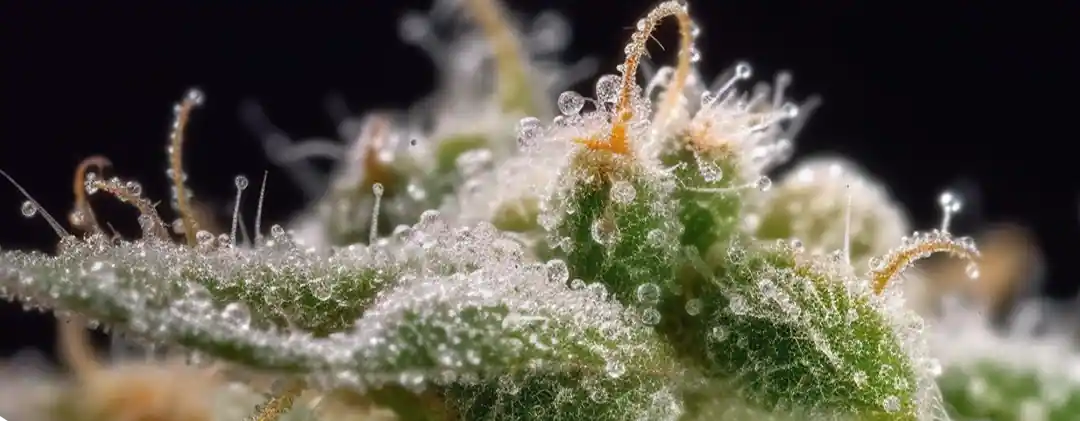
Various Types of Cannabis Trichomes
Don't be fooled by their tiny size. Even though they're micro in stature, they exhibit a wide variety in their structure. Cannabis accommodates three main trichome types: Capitate-Stalked Trichomes, Capitate-Sessile Trichomes, and Bulbous Trichomes.
|
Type |
Description |
Features |
|---|---|---|
|
Capitate-Stalked Trichomes |
The largest and most abundant of cannabis trichomes. It can be seen by the naked eye as tiny crystals on the bud. |
Rich source of THC and CBD, essential to both medical and recreational cannabis consumers. |
|
Capitate-Sessile Trichomes |
Smaller than their stalked counterparts, these trichomes lack a distinct stalk. Appear when the plant begins to flower. |
While less potent, they still produce a significant amount of cannabinoids and terpenes. |
|
Bulbous Trichomes |
The smallest of the three types, measuring between 10-15 micrometers. Gives the plant a glossy sheen. |
Despite their size, they contribute to the overall cannabinoid and terpene profile of the plant. |
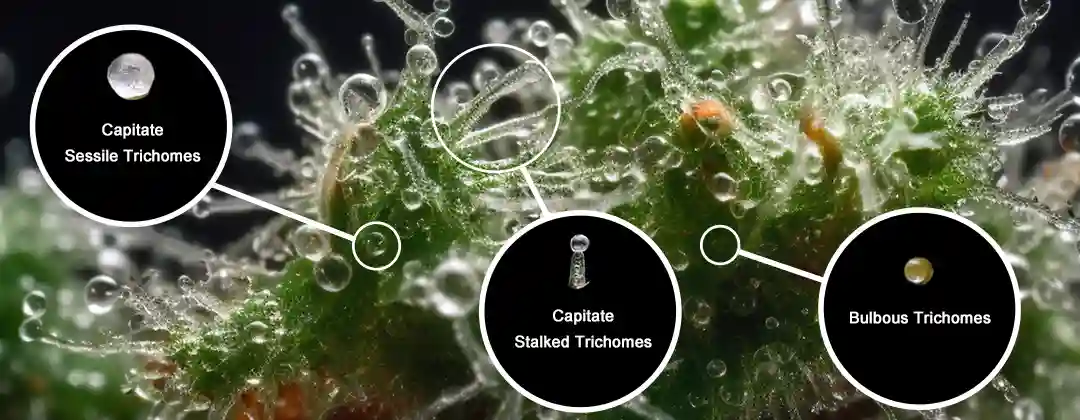
No matter how small they may seem, trichomes have a significant impact on the cannabis experience, affecting everything from the strain's potency to its flavor and therapeutic effects. Next time you admire the crystalline sparkle of a cannabis bud, remember: you actually appreciate the magnificent world of trichomes!
Role of Trichomes in Cannabinoid Production
The magic of trichomes lies in their role as the cannabinoid factories of the cannabis plant. Here, compounds like THC, CBD, and terpenes find their origin.
The aromatic terpenes that give strains their unique smell and taste, the calming CBD, the psychoactive THC— all start within the confines of these microscopic structures. Truly, the world of cannabis would not be the same without the essential work of trichomes!
When Do Trichomes Appear on Cannabis
Just like the beautiful fall foliage, trichomes don't appear all at once. As the cannabis plant enters its flowering stage, trichomes begin to form, initially appearing as tiny, clear hair-like protrusions. As the plant matures, these trichomes grow, shift from clear to a milky white, and eventually take on an amber hue.
Growers often gauge the readiness of their cannabis for harvest based on the color of the trichomes, making them more than just a factory for cannabinoids— they're the plant's personal timekeeper too!
What Do Trichomes Look Like
Unlike pistils, the hair-like structures on cannabis that morph from white to orange as the plant matures, trichomes are the tiny, glistening appendages covering your bud.
Each trichome is a minuscule factory of sorts, producing the compounds that make cannabis so unique. Under magnification, trichomes have a mushroom-like appearance. In their early stages, they're clear. As they mature, they take on a cloudy or milky hue, and towards the end of their lifecycle, they turn amber. To the naked eye, they could be mistaken for fine hairs or a glistening coating, somewhat like frost on a winter morning.
Though trichomes may seem visible to the naked eye as a sparkly layer on your cannabis, a closer examination is needed to truly appreciate their complex structure and beauty.
How to Check Trichomes Without a Microscope
Checking trichomes doesn't have to be a science experiment involving sample collection and a traditional microscope. If you'd like to observe your plant's trichomes without sacrificing a piece of your precious bud, there are easier—and cheaper—alternatives.
Have you considered a jeweler’s loupe? Usually used to examine precious gems for imperfections, a loupe is pocket-sized and straightforward to use. Plus, you can capture impressive trichome photos by placing it in front of your phone's camera lens.
Your smartphone could be your most accessible tool. Many modern phone cameras boast high-definition zoom capabilities that allow you to study your cannabis plant up close. Test out your camera app, and you'll be surprised at the level of detail you can capture.
USB microscopes are another user-friendly option that lets you get up close and personal with your plant's trichomes, bypassing the need for any physical sampling. In a pinch, a common magnifying glass can also do the trick, although the view might be less refined.
Moldy Weed vs Trichomes: How to Tell the Difference
Here comes the tricky part: sometimes, it's hard to tell the difference between moldy weed and trichomes. Both can have a fuzzy appearance, but the comparison stops there. So, how do you tell them apart?
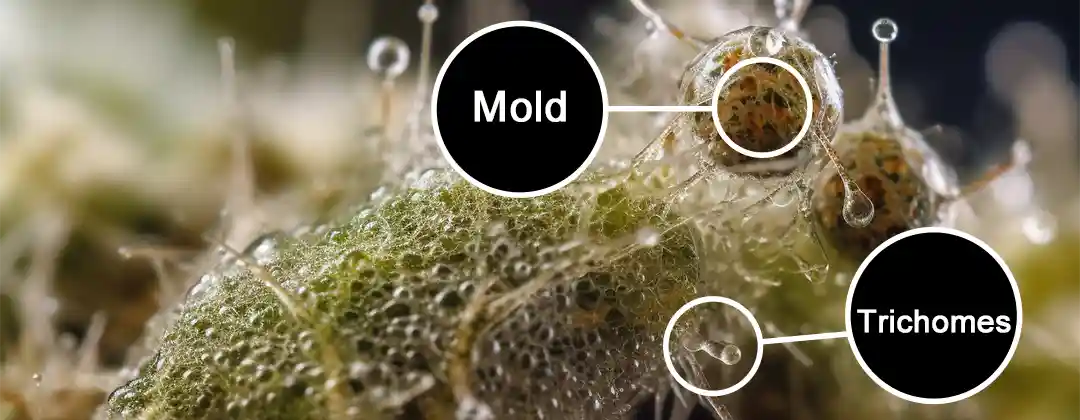
Visual Clues to Differentiate Mold from Trichomes on Cannabis
Visual cues are your first line of defense in telling mold and trichomes apart. Remember, trichomes are a natural part of the plant, and they appear as a crystal-like layer on the surface of your cannabis.
Mold, on the other hand, is an unwelcome guest. It often appears as a powdery, flour-like substance and might be accompanied by dark spots or a slimy texture.
Taste as a Distinguisher: What Does Mold on Weed Taste Like
Next, we have the taste test. A little tip: cannabis should never taste musty or unpleasantly earthy. A moldy taste can be a sign that something is wrong. Trichomes, which contribute to the plant's flavor profile, should give your cannabis a flavor that's unique to its strain. But remember, tasting should be a last resort. If you're unsure, it's better not to consume potentially moldy cannabis.
The Smell Test: Deciphering the Aroma of Moldy Cannabis vs Trichomes
The aroma of cannabis is a delightful mix of scents, all thanks to the terpenes in trichomes. A moldy cannabis, however, smells, well, moldy! Think damp basement or old attic. It's a smell that's not typical of fresh, healthy cannabis. If your weed's aroma gets your nose wrinkling, it's time to investigate further.
The Microscopic World: Distinguishing Mold on Trichomes
Looking at cannabis under a microscope is the definitive way to tell the difference between mold and trichomes. Trichomes should appear as clear, stalked structures with bulbous heads.
Mold, on the other hand, appears web-like and doesn't have a defined structure.
You can stay safe and enjoy your cannabis experience if you have a microscope handy.
How the Effects of Mold and Trichomes Differ on Human Health
The differences in the effects of mold and trichomes on human health are night and day. While trichomes contain beneficial compounds like THC and CBD, mold can lead to serious health issues, ranging from allergic reactions to severe lung problems. It's crucial to ensure that you're consuming safe, mold-free cannabis for a healthy and enjoyable experience.
Differences in the Role and Function of Mold and Trichomes on Cannabis
Lastly, let's consider the role and function of mold and trichomes on cannabis. Trichomes play a crucial part in the cannabis plant's life, being the birthplace of cannabinoids, terpenes, and flavonoids that we have grown fond of.
Mold, conversely, acts like a wrench in the works for the cannabis plant, hampering its growth and degrading its overall quality.
When it comes to mold vs trichomes, it's clear who the villain is. So, stay safe, stay informed, and enjoy your cannabis responsibly.
Moldy Weed and Trichome Growth: Prevention and Promotion
No one enjoys the sight of moldy weed. Not only does it impair the experience, but it can also threaten safety. On the other hand, trichomes are the glittering gems that cannabis connoisseurs cherish. So, how do we keep the mold out and invite healthy trichome growth? Here's how:
Techniques to Prevent Moldy Weed
Staving off mold is a task that requires consistent dedication. A few tips and tricks, however, can help you keep your cannabis fresh and potent.
Ideal Storage Conditions to Prevent Mold on Weed
When it comes to storing cannabis, think cool, dark, and dry. Light and heat stimulate mold growth. Storing your weed in a cool, dark place can help avoid this problem. Likewise, overly moist environments are a breeding ground for mold, so ensure your cannabis is completely dry before storage.
Monitoring Humidity - A Critical Factor in Mold Prevention
Humidity and mold are best buddies; we want to keep them apart. Ideally, your storage environment should maintain relative humidity between 55% and 62%. If you live in a humid climate, consider using airtight jars with humidity-control packs to optimize your storage conditions.
Best Practices for Weed Hygiene to Avoid Mold
Be an ardent follower of cleanliness. This includes your hands, tools, and of course, the storage area. Regular cleaning can keep mold at bay. Make sure your cannabis containers are sanitized and thoroughly dry before use. Cleanliness also applies to the growing area if you're cultivating your own cannabis.
The Role of Ventilation in Preventing Mold on Cannabis
Good airflow goes a long way in preventing mold. Stagnant air creates a humid, mold-friendly environment. Ensure your storage area is well-ventilated. If you're growing cannabis, proper air circulation in the grow area is essential.
Remedial Actions in Case of Mold Infestation on Cannabis
Despite our best efforts, mold can still occur. If you spot moldy cannabis, remove it immediately to prevent the spread. Then, review your storage conditions and make necessary adjustments to avoid future issues. Remember, smoking moldy weed is harmful. When in doubt, throw it out.
Tips to Promote Healthy Trichome Development
While keeping mold at bay, let’s not forget our trichomes. Here are some tips for encouraging healthy trichome development:
- Lighting: Ensure your cannabis gets the right spectrum of light. LED lights are known to stimulate trichome production.
- Nutrients: Feed your cannabis the right mix of nutrients. Nitrogen, phosphorus, and potassium are essential.
- Stress: A bit of stress can go a long way in boosting trichome production. Techniques such as pruning can be effective.
- Harvesting: Pick your cannabis when the trichomes are mature to preserve their benefits. Timing is everything.
Controlled Environment: Consider using Altaqua's state-of-the-art grow room HVAC systems. They provide optimal temperature, humidity, and ventilation conditions for promoting trichome development.
By balancing the prevention of mold and the promotion of trichomes, we can optimize our cannabis experience and enjoy the best this remarkable plant has to offer.
Final Thoughts on Moldy Weed vs Trichomes
Moldy weed is a nuisance that can compromise the quality and safety of your cannabis. From visual checks to the sniff test, learning how to spot it can help keep your cannabis experiences positive and safe. The prevention techniques we've discussed, like ideal storage conditions, monitoring humidity, and proper ventilation, can make a world of difference in keeping the mold away.
Conversely, trichomes are the sparkling jewels of the cannabis world, adding to its strength and taste. Boosting their growth isn't only about enhancing your cannabis, but also demonstrating a cultivated respect for this plant. The right blend of light, nutrients, and well-balanced stress can stimulate robust trichome growth.
Keep in mind, the ultimate objective isn't simply to enjoy cannabis, but to comprehend it, esteem it, and optimize all the advantages it provides. By doing so, we assure that every interaction with cannabis is marked by quality, safety, and enjoyment.
FAQ
1.What is the difference between moldy weed and trichomes?
Trichomes are naturally occurring, tiny, crystal-like structures on cannabis plants, producing cannabinoids like THC and CBD. Mold, however, is a harmful foreign entity that can negatively affect the quality of the cannabis and pose health risks if consumed.
2.How can I identify mold on my cannabis?
Mold on cannabis may appear as fuzzy, white patches, unlike the crystalline appearance of trichomes. It may also cause an off smell or taste. When in doubt, it's best to inspect the weed under a microscope.
3.What conditions favor the growth of powdery mildew on cannabis?
Cannabis powdery mildew thrives in conditions of high humidity with insufficient air circulation. While it can survive in low humidity, it prefers environments where moisture levels are stable rather than fluctuating.
4.What are the types of trichomes found on cannabis?
There are three primary types of trichomes found on cannabis: Capitate-Stalked Trichomes, Capitate-Sessile Trichomes, and Bulbous Trichomes. Despite their microscopic size, they play an essential role in producing the therapeutic and psychoactive compounds of cannabis.
Share with your friends:
Popular Blogs on Altaqua:
Get HVAC Brochure?
Get HVAC Brochure?
